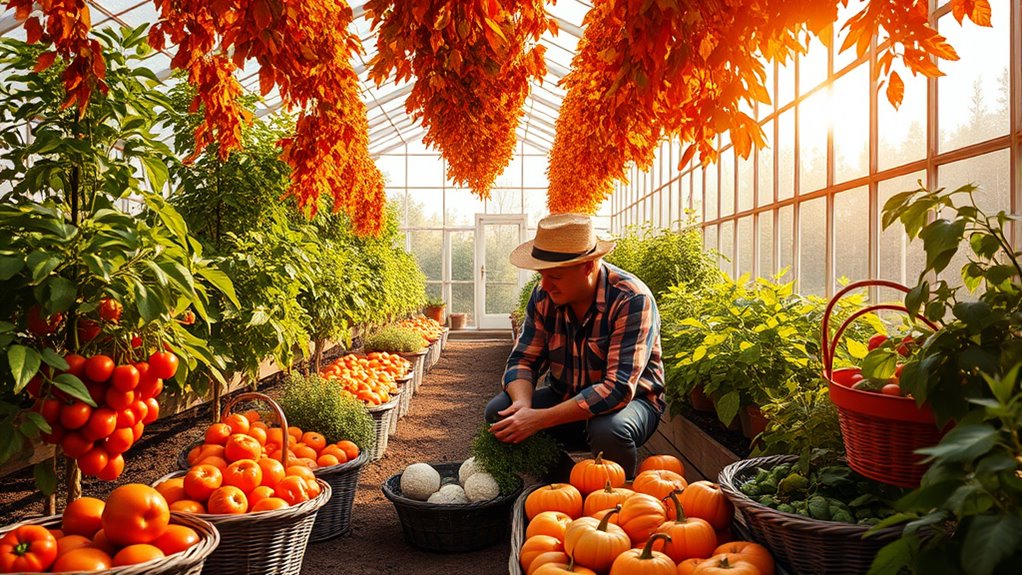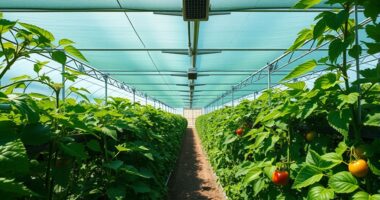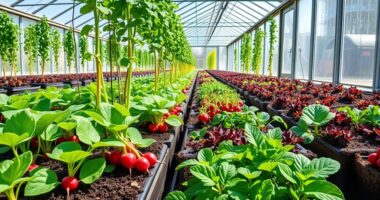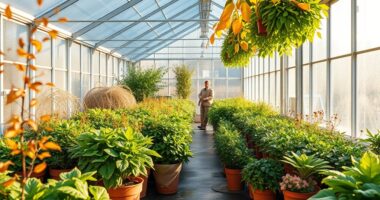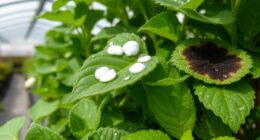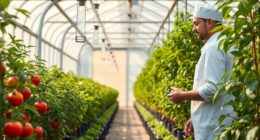For a successful fall harvest in your greenhouse, start by choosing hardy crops like kale, radishes, and brassicas. Optimize your soil by testing pH and adding compost to enrich it. Use season extension techniques like hoop houses and row covers to protect your plants from frost. Manage temperatures and humidity carefully, adjusting watering as needed. Keep an eye out for pests and diseases. Keep going to discover even more tips for a bountiful fall harvest!
Key Takeaways
- Monitor greenhouse temperatures closely, maintaining them between 68 to 78 °F for optimal plant growth during fall.
- Implement season extension techniques like hoop houses and row covers to protect crops from frost.
- Harvest crops like kale and brussels sprouts after the first frost for improved flavor and quality.
- Reduce watering frequency, checking moisture levels before watering to prevent over-saturation in cooler weather.
- Ensure adequate ventilation to maintain humidity levels and prevent mold growth during the fall season.
Choosing the Right Crops for Fall
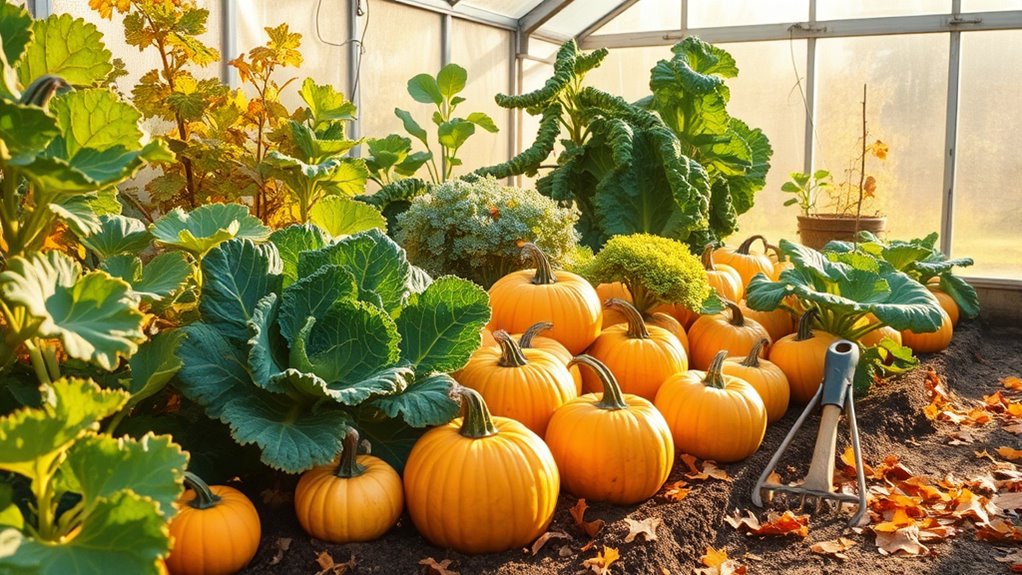
When you’re planning your fall greenhouse garden, it’s crucial to choose the right crops that thrive in cooler temperatures.
Start with hardy greens like lettuce, spinach, and kale—they not only grow quickly but also taste better after a frost.
Hardy greens like lettuce, spinach, and kale not only flourish in cooler temperatures but also develop enhanced flavors after frost.
Radishes and beets are fantastic choices too, as they mature swiftly.
Don’t overlook brassicas; broccoli and cabbage flourish in cooler weather, while Brussels sprouts can extend your harvest into late fall.
Incorporating root vegetables like carrots and leeks will ensure a diverse harvest.
Lastly, consider herbs like cilantro and parsley, which thrive in the chill.
Additionally, you can maximize your yield by utilizing season extension techniques to help your crops flourish longer into the fall.
Optimizing Soil Preparation for Fall Planting

To achieve a successful fall harvest, optimizing your soil preparation is essential. Start with soil pH testing to ensure it’s slightly acidic to neutral, which most plants prefer.
Assess nutrient levels to determine if you need additional fertilizers for growth. Check for compaction; loosening the soil promotes better root development.
Incorporate organic matter like compost to enrich and improve soil structure. Turn and aerate the soil for better drainage.
Don’t forget about mulching to retain moisture and suppress weeds. Finally, consider adding amendments like worm castings or biochar to boost fertility.
With these steps, your soil will be primed for healthy fall planting and robust crops.
Implementing Season Extension Techniques

Implementing season extension techniques not only maximizes your greenhouse’s productivity but also helps you enjoy fresh produce well into the colder months.
Consider using hoop houses or polytunnels to provide warmth and protection from harsh weather. Cold frames and row covers can shield your plants from frost while allowing sunlight and moisture in.
Utilize hoop houses and cold frames to shield your plants from frost while ensuring they receive sunlight and moisture.
Staggered plantings will ensure a continuous harvest, so incorporate fast-growing crops like lettuce alongside long-season varieties such as kale. Don’t forget to choose cold-hardy varieties to thrive in cooler temperatures.
Additionally, maintaining protective structures and monitoring conditions will keep your plants healthy.
With these strategies, you’ll extend your growing season and savor fresh vegetables long after the first frost.
Managing Temperature and Light in Your Greenhouse

Managing temperature and light in your greenhouse is crucial for ensuring vibrant plant growth and maximizing your harvest. Keep your greenhouse temperatures between 68 to 78 °F for most plants. Utilize properly sized heating and cooling systems, and consider smart controllers to automate adjustments.
Make sure to ventilate adequately to prevent overheating.
Position your greenhouse for at least eight hours of sunlight, and use shade curtains to block light during peak hours. Install supplemental lighting to counter reduced daylight in fall.
Regularly maintain your lighting systems for optimal performance. Finally, monitor conditions with thermometers and sensors, adjusting settings based on seasonal changes and specific plant needs to promote healthy growth and prevent heat damage.
Effective Watering and Humidity Control Strategies

As the temperatures drop in fall, adjusting your watering and humidity control strategies becomes essential for maintaining healthy plants in your greenhouse.
Start by reducing your watering frequency; plants need less moisture as they become less active. Check the growing medium’s moisture by squeezing it—if it crumbles, it’s time to water. Always water early in the day to allow foliage to dry, minimizing disease risk.
Monitor container weight to gauge moisture levels accurately. For humidity control, maintain optimal levels to prevent mold growth. Use dehumidifiers and ensure good air circulation to avoid stagnant moisture.
Pest and Disease Management for Fall Crops
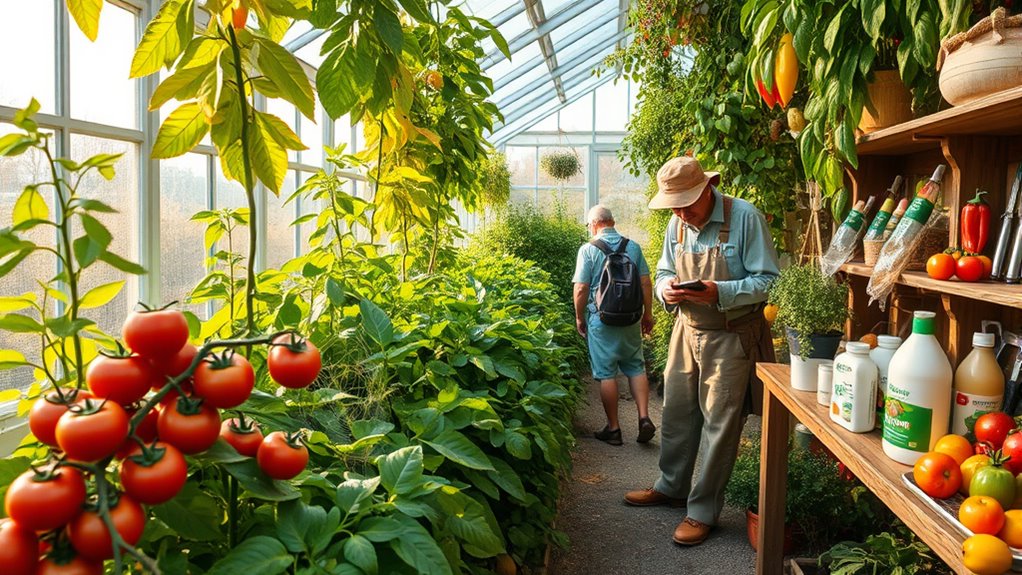
With the cooler fall temperatures in your greenhouse, it’s vital to stay vigilant about pests and diseases that can threaten your crops.
Regularly inspect the undersides of leaves and stems to catch infestations early. Watch for common pests like aphids, whiteflies, and fungus gnats, which can also transmit diseases.
Regular inspections of leaves and stems are crucial for early detection of pests like aphids, whiteflies, and fungus gnats.
Utilize insect screening and UV-reflective mulch to deter pest entry. Consider beneficial insects or neem-based oils to manage pest populations biologically.
If needed, organic treatments like insecticidal soap or diatomaceous earth can effectively control outbreaks.
Don’t forget to maintain cleanliness and sanitation around your greenhouse to prevent pests from settling in.
Harvesting Techniques for Maximum Yield
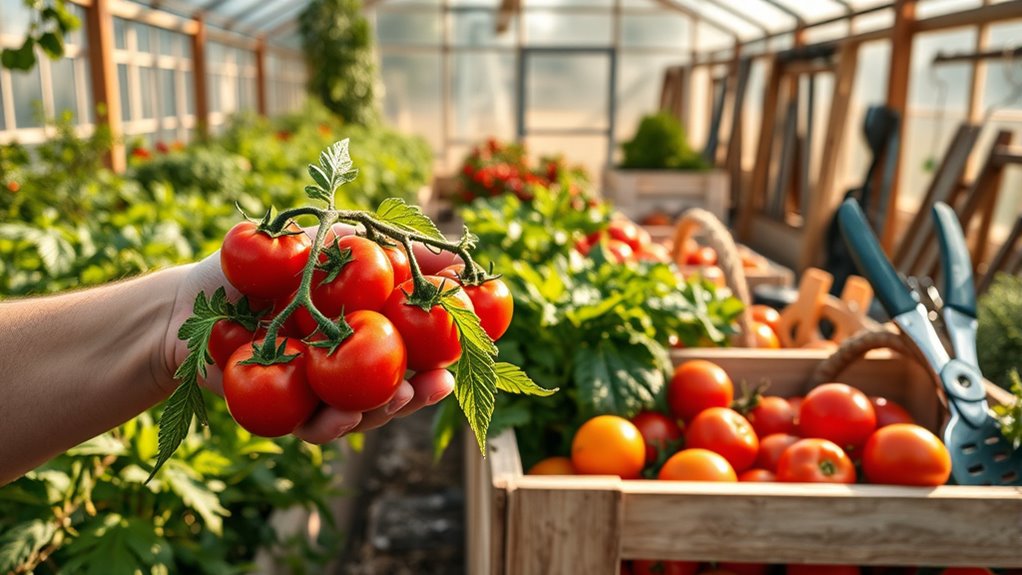
To maximize your harvest yield in the fall, it’s essential to employ effective techniques that cater to the unique needs of your crops.
Consider succession planting for continuous harvests; plant small batches of radishes and lettuce regularly. Use the “cut and come again” method for greens—harvest at the crown to encourage new growth.
Delay thinning root crops until you need them, as thinned plants can contribute to your harvest. When handling root crops, remove tops post-harvest to minimize water loss.
Finally, store greens properly; use paper towels and air bubbles in bags to keep them fresh longer.
Frequently Asked Questions
How Can I Prevent Overcrowding in My Greenhouse During Fall?
To prevent overcrowding in your greenhouse during fall, ensure you space plants adequately to promote healthy growth.
Prune or train them as needed to maintain size and encourage bushiness. Maximize light exposure by optimizing plant placement and using clean glazing.
Regularly monitor growth to identify overcrowding issues early, and adjust your irrigation and nutrient delivery to support the plants without forcing them to compete for space.
Keeping these strategies in mind will enhance your greenhouse’s productivity.
What Tools Are Essential for Fall Greenhouse Gardening?
In the world of greenhouse gardening, having the right tools is like wielding a magic wand for your plants!
You’ll need scissors and snips for precise cuts, hand pruners to keep everything healthy, and trowels for easy soil handling.
Don’t forget rakes for debris removal and scoops for transferring soil.
Keeping your tools clean with brushes and antibacterial soap is essential to prevent disease.
Equip yourself, and watch your greenhouse thrive!
How Do I Store My Fall Harvest Effectively?
To store your fall harvest effectively, start by ensuring you’ve got the right temperature and humidity levels.
Keep root vegetables like carrots at 32°F and maintain high humidity for crops like kohlrabi.
Use proper packaging to allow airflow, and store light-sensitive items like potatoes in darkness.
Consider methods like canning, freezing, or dehydrating to extend shelf life.
Don’t forget to clean your storage equipment to prevent spoilage!
Can I Grow Fall Crops in Containers?
Absolutely, you can grow fall crops in containers! Many believe that fall gardening requires traditional beds, but containers offer flexibility and convenience.
Choose pots that are at least 18 inches deep for root space, and use quality potting soil mixed with compost.
You’ll love how easy it’s to move them for optimal sunlight. With the right care, crops like lettuce, kale, and even garlic will thrive beautifully in your containers this fall.
What Are Signs of Over-Fertilization in Fall Crops?
If you notice signs of over-fertilization in your fall crops, look for yellowing or browning leaves, particularly at the bottom.
You might see slow growth or even leaf drop, which could confuse you with other issues. Check the roots for blackened or rotting sections due to salt buildup.
Additionally, a crust on the soil surface is a clear indicator that you’ve applied too much fertilizer.
Adjust your practices to prevent further damage.
Conclusion
As you wrap up your fall harvesting, remember that the right crops, soil prep, and season extension techniques can work wonders. With careful management of temperature, light, and humidity, you’ll keep your plants thriving. Don’t forget to stay vigilant against pests and diseases, ensuring a bountiful yield. In the end, it’s all about timing and care, creating a cycle of growth that leads to fruitful harvests season after season. Embrace the rhythm, and watch your greenhouse flourish!
